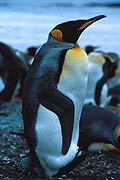
(Click to enlarge)
King penguins preen to keep their feathers clean and well oiled to ensure they are waterproof. A layer of air is trapped beneath the feathers, next to the skin.
|

(Click to enlarge)
Hustle and bustle, noise and smell! Royal penguin parents are kept busy feeding hungry chicks! |
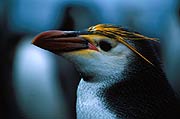
(Click to enlarge)
Royal penguin
|
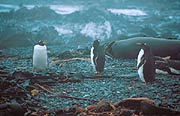
(Click to enlarge)
Gentoo penguins are rather shy and not so
many are found on the island. |
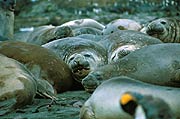
(Click to enlarge)
Elephant seals look comfortable when lying close together. 80-90 000 Elephant seals breed and moult on Macquarie Island. |
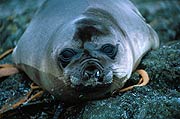
(Click to enlarge)
A young elephant seal, known as a "weaner". Pups weigh 40 kg when they are born, they are weaned at 24 days and weigh around 120 kg. That milk must be exceptionally good! Adult females weigh 300-900 kg and males are huge, they weigh up to 3000 kg.
|
| |
|
|
The Parks and Wildlife Service have been working on all types of wildlife projects on the island for many years. Since the days of the sealers there have been cats, rats and rabbits on the island. This photo was taken over ten years ago by the Parks and Wildlife ranger, Geof Copson. In the late 1990's, with Federal Government assistance the PWS undertook to eradicate cats from the island.
The cats were creating havoc, eating many different birds which came to the island to breed and raise chicks. It was no life for the cats, with the wild weather and always having to hunt for food. An enormous effort has been made over many years by dedicated rangers and
assisting staff to remove cats from the island. This involved thousands of
hours walking all over the island working in all conditions, often wild and
windy weather, hail and rain. Most of the field work was undertaken
during the night.
The program has been successful as no cats have been seen for at least three years. The small burrowing birds are beginning to return to the island. Hopefully now populations will begin to recover.
|
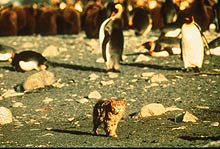
(Click to enlarge) |
| |
|
Research is undertaken on the wandering albatross. With a wingspan of 3.5 m (the length of an average family car) this magnificent bird travels right across the Southern Ocean in search of food. They have been tracked and known to fly 25 000 km in less than 5 weeks. Numbers have dramatically declined, and the high seabird mortality has been linked to longline fisheries,
Fewer than ten pairs come to the south of the island to raise young. Researchers are coming up with technological solutions to try to prevent these incredible birds from being accidentally caught by longline fisheries. We were lucky enough to see this magnificent bird at sea.
Graeme Robertson at the Australian Antarctic Division has just received an award.
|

(Click to enlarge)
Wandering albatross |
Even here, kilometres from anywhere, rangers like Terry Reid find marine debris. The many items that wash ashore are collected to prevent seals and seabirds becoming entangled. This picture of Terry Reid's was taken a few years ago when the rangers were still trying to rid the island of cats. Can you think of any ways to decrease rubbish in the sea?
After a fabulous time photographing and watching the wildlife, we leave behind the huge numbers of birds and seals and continue our journey south. As I watch the island disappearing in the beautiful afternoon sunshine, I am left thinking how amazing nature is and wondering what the rest of the world would look like if we had fewer humans. How can we minimise our human impact on nature? |
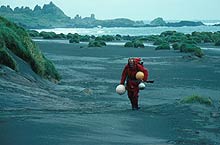
(Click to enlarge)
Terry Reid collecting marine debris |